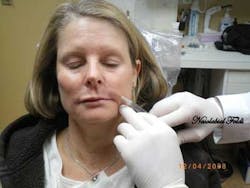Tearing/rough surfaces2. Tight crowns: This problem can be caused by early removal of the impression tray from the mouth, a poor bond of the material to the tray, or seating an impression tray with material that is partially set. Again, closely follow the recommended working and setting times, and always use a VPS tray adhesive according to instructions. 3. Short crowns: Trays with weak or low walls can provide insufficient support during impressioning, leading to short crowns. To address this issue, use custom or inflexible trays — preferably metal. Short crowns can also be due to teeth coming into contact with the tray, so instruct patients before seating and confirm that teeth do not touch the tray. 4. Voids: As dentists know, voids are one of the most common impressioning issues. On the margin of an impression, voids can compromise the restoration’s fit and function. If you experience this issue, your syringe technique may need improvement. Use a stirring motion while syringing, making sure to keep the syringe tip immersed to avoid trapping air. Alternately, air may become inadvertently incorporated in the syringe when loading. To avoid this, front load the syringe by inserting the mix tip directly into the syringe and forcing the plunger backwards.
- When voids occur on occlusal surfaces, they can lead to problems with articulation of stone models. In this instance, moisture is frequently the cause of the problem, whether it is present in the sulcus or pooled on occlusal surfaces. To counter this issue, monitor for pools of water or saliva before inserting the impression tray. Control bleeding, and use the two-cord retraction technique and/or hemostatic agents in appropriate cases.
5. Tray seating: The tray seating step presents the possibility for a number of errors.
- If ledges are an issue, try not to seat the tray too rapidly. Position the tray before seating, and use a slow, steady, vertical seating motion.
- Drags can result when the tray is placed and seated in one motion. They can also occur when teeth rebound off the tray and slide into position. Similar to the technique for avoiding ledges, seat the tray slowly after carefully positioning it in the mouth, and avoid contact of teeth with the tray.
- Both rocking crowns and slanted or wavy teeth can be caused by tray movement after seating. Use passive pressure on the tray to immobilize it for the full recommended oral set time.
6. Bite registration: When excessive occlusal adjustment is necessary for restorations, poor interocclusal records are likely a factor. To combat this, use a dimensionally stable bite registration material, and ensure it is trimmed properly. Additionally, monitor patients to confirm they do not move during the procedure.
7. Surface inhibition: If the surface of the impression material is not set, tacky to the touch, and visually resembles the surface of an orange peel, a number of factors may be the culprit. The impression material may have been exposed to air-inhibited methacrylates or residues from custom temporary materials. Avoid this problem by waiting to fabricate the temporary crown until after the final impression has been made and using an alcohol wipe to remove the air-inhibited layer on any composites, adhesives, or core buildups in the impressioning area.
With a reliable impression material, such as 3M™ ESPE™ Impregum™ Soft Polyether Impression Material, and the right technique, impression-taking can be predictable and highly accurate. For more tips and information, visit www.3MESPE.com/GreatImpressions.









